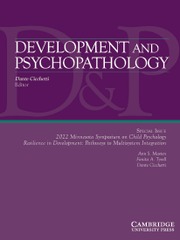Article contents
Adolescents’ externalizing behaviors and antisocial text messaging across the broader peer network: Implications for socialization and selection effects
Published online by Cambridge University Press: 13 August 2019
Abstract
Adolescents’ peer networks provide an important context that can contribute to increases in antisocial behavior. By a process called deviancy training, peers can both model and reinforce these behaviors, thereby conveying group norms about the acceptability of such behaviors. This research examined the relationship between the proportion of adolescents’ peers who exchanged antisocial text messages and externalizing behaviors during high school. In Study 1, parent-, teacher-, and self-reports of rule-breaking and aggression were collected for a sample of adolescents (n = 167, 80 girls; 22.2% Black, 51.5% Caucasian, 18.7% Hispanic) during the summers before and after 9th grade. Total text frequency, frequency of antisocial texts, and the proportion of the peer network who exchanged antisocial messages were examined as predictors of antisocial behavior. The proportion of peers who exchanged antisocial texts significantly predicted rule-breaking, but not aggression. Study 2 examined the direction of the relationship documented in Study 1 more thoroughly. Externalizing behaviors at 9th, 10th, and 11th grade were evaluated as predictors of the proportion of the peer network that exchanged texts about antisocial topics (n = 205, 98 girls; 22.4% Black, 53.7% Caucasian, 16.9% Hispanic). Externalizing behaviors predicted the proportion of adolescents’ peer network that exchanged antisocial texts in each of the subsequent years, but this proportion of the peer network exchanging antisocial communication did not predict subsequent externalizing behaviors. The findings suggest that the extent to which antisocial communication permeates the peer group is a selection effect.
Information
- Type
- Special Issue Articles
- Information
- Development and Psychopathology , Volume 31 , Special Issue 5: Honoring the Contributions and Legacy of Thomas Dishion , December 2019 , pp. 1619 - 1631
- Copyright
- Copyright © Cambridge University Press 2019
References
- 7
- Cited by

